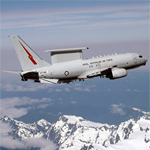South Korea unveils first surveillance aircraft

As a hope of making another great leap in improving South Korea’s military might, South Korea’s first surveillance airplane, known as Airborne Early Warning and Control plane, arrived at an Air Force base on Aug. 1. The Defense Acquisition Program Administration (DAPA) in Seoul said that a Boeing E-737 early-warning and control aircraft landed at the Air Force base in Gimhae, South Gyeongsang, after completing tests by South Korean Air Force at Boeing’s factory in Seattle.
“It will go through test flights and acceptance tests before it’s handed over to our Air Force in early September,” the DAPA said.
In an effort to establish autonomous early-warning and control system, South Korean military had decided to adopt E-737 in November 2006. Since then Seoul has been doing its effort to bring four such planes by end of 2012. Currently, Korea Aerospace Industries, the nation’s leading aircraft maker, is developing advanced multi-purpose electronic satellite radar system that will be installed in the second, third and fourth planes. They are planned to be handed over to South Korean Air Force in 2012.
“If necessary, early-warning and control airplane is capable of monitoring the whole land of North Korea,” said a defense official at the Defense Ministry in Seoul. “Not only the plane can monitor target areas real-time, but also it can improve airborne operations significantly by assisting air-defense system on ground. The surveillance plane will also be capable of checking airborne or seaborne targets on the entire Korean Peninsula, and will be able to catch aircraft flying at low altitude infiltrating mountainous areas.”
A 120-seater E-737 surveillance aircraft was made by remodeling Boeing 737 passenger plane, such as installing Multi-role Electronically Scanned Array (MESA) Surveillance Radar on top of plane body and radar manipulating consol system inside the aircraft. DAPA said such systems are capable of detect, distinguish, monitor and analyze targets in the air and on sea spontaneously. When new E-737 plane is in full operation, it will observe whole operational area and provide core information of enemies to South Korea’s fighters and warships.
Apart from a old early warning and control plane, the new E-737 aircraft uses electronically scanned array radar which is capable of not only covering omni-directional area but also focusing on a specific target exploration. Experts anticipate that the use of the new plane could upgrade South Korea’s military power significantly. They also hope that the plane could contribute in improving independent intelligence gathering and monitor capabilities after the transition of wartime operational control from the United States to South Korea.
The new E-737 has a flying range of around 7,000 kilometers (4,349 miles) and it can fly on patrol for about eight to nine hours. MESA radar can detect and monitor some 1,000 target planes at the most. It also has a capability of interlocking with strategic data link system of Air Force air-defense units.
The aircraft has been dubbed “Peace Eye” after a naming contest in 2008. It has a meaning of demonstrating peace missions in and out of the Korean Peninsula where it remains the only divided land in the world.